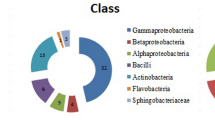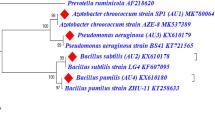Abstract
It has been well known that the bacteria of the genus Azotobacter, in addition to the beneficial N2-fixing activity, are able to improve plant growth by a number of direct and indirect mechanisms. To identify this potential in indigenous azotobacteria, the efficiency of 17 isolates of Azotobacter from the rhizosphere of wheat and barley plants cultivated in salt- and/or drought-affected soils in Iran were evaluated for their ability to dissolve inorganic and organic phosphates, siderophore secretion, indole acetic acid (IAA) production; and protease, chitinase, and ACC deaminase (ACCD) activities. First, they were biochemically characterized and one isolate (strain) was identified by 16S rDNA sequencing. Eight isolates were designated as Azotobacter vinelandii and the remaining isolates were identified as A. chroococcum. All isolates hydrolyzed the organic and inorganic phosphate compounds and effectively produced IAA. Fifteen isolates produced siderophore, but only one isolate showed protease activity which is being reported for the first time in relation to Azotobacter. None of the 17 isolates was capable of producing ACCD or chitinase. However, polymerase chain reaction amplification of the ACCD coding genes, by the use of the gene-specific primers, indicated that not all contain the ACCD gene. The standard screening methods with slight modifications, especially in the case of ACCD assay, were applied. The results showed that the use of specific screening methods, modified according to bacterial nutritional requirements, are the efficient methods for precise evaluation of the plant growth promoting rhizobacteria activity.




Similar content being viewed by others
References
Alikhani HA, Saleh-Rastin N, Antoun H (2006) Phosphate solubilization activity of rhizobia native to Iranian soils. Plant Soil 287:35–41
Aquilanti L, Favilli F, Clementi F (2004) Comparison of different strategies for isolation and preliminary identification of Azotobacter from soil samples. Soil Biol Biochem 36:1475–1483
Bradford MM (1976) A rapid and sensitive method for the quantitation of microgram quantities of protein utilizing the principle of protein dye binding. Anal Biochem 72:248–254
Chet I, Inbar J (1994) Biological control of fungal pathogens. Appl Biochem Biotechnol 48:37–43
Dowling DN, O’Gara F (1994) Metabolites of Pseudomonas involved in the biocontrol of plant disease. Trends Biotechnol 12:133–141
Dowling DN, Sexton R, Fenton A, Delany I, Fedi S, McHugh B, Callanan M, Moenne-Loccoz Y, O’Gara F (1996) Iron regulation in plant-associated Pseudomonas fluorescens M114: implications for biological control. In: Nakazawa K, Furukawa K, Haas D, Silver S (eds) Molecular biology of Pseudomonads. ASM Press, Washington, DC, pp 502–511
Farajzadeh D, Aliasgharzad N, Sokhandan Bashir N, Yakhchali B (2010) Cloning and characterization of a plasmid encoded ACC deaminase from an indigenous Pseudomonas sp. FY32. Curr Microbiol 61(1):37–43
Glick BR (1995) The enhancement of plant growth by free-living bacteria. Can J Microbiol 41:109–117
Glickmann E, Dessaux Y (1995) A critical examination of the specificity of the Salkowski reagent for indolic compounds produced by phytopathogenic bacteria. Appl Environ Microbiol 61:793–796
Gould WD, Hagedorn C, Bardinelli TR, Zablotowicz RM (1985) New selective media for enumeration and recovery of fluorescent pseudomonads from various habitats. Appl Environ Microbiol 49:28–32
Holt JG, Krieg NR, Sneath PHA, Staley JT, Williams ST (1994) Bergey’s manual of determinative bacteriology. Lippincott Williams & Wilkins, USA
Kloepper JW, Lifshitz R, Zablotowicz RM (1989) Free-living bacterial inocula for enhancing crop productivity. Trends Biotechnol 7:39–44
Mrkovacki N, Milic V (2001) Use of Azotobacter chroococcum as potentially useful in agricultural application. Ann Microbiol 51:145–158
Muhammadi Nuzhat A (2007) Genetics of bacterial alginate: alginate genes distribution, organization and biosynthesis in bacteria. Curr Genomics 8:191–202
Nukui N, Minamisawa K, Ayabe SI, Aoki T (2006) Expression of the 1-aminocyclopropane-1-carboxylic acid deaminase gene requires symbiotic nitrogen-fixing regulator gene nifA2 in Mesorhizobium loti MAFF303099. Appl Environ Microbiol 72:4964–4969
Okon Y, Labandera-Gonzalez CA (1994) Agronomic applications of azospirillum: an evaluation of 20 years worldwide field inoculation. Soil Biol Biochem 26:1591–1601
Page DMR (1996) TreeView: an application to display phylogenetic trees on personal computers. Comput Appl Biosci 12:357–358
Pandey A, Sharma E, Palni LMS (1998) Influence of bacterial inoculation on maize in upland farming systems of the Sikkim Himalaya. Soil Biol Biochem 30:379–384
Pati BR, Sengupta S, Chandra AK (1995) Impact of selected phyllospheric diazotrophs on the growth of wheat seedlings and assay of the growth substances produced by the diazotrophs. Microbiol Res 150:121–127
Penrose DM, Glick BR (2003) Methods for isolating and characterizing ACC deaminase-containing plant growth-promoting rhizobacteria. Physiol Plant 118:10–15
Radwan FI (1998) Response of some maize cultivars to VA—mycorrhizal inoculation, biofertilization and soil nitrogen application. Alex J Agric Res 43:43–56
Saitou N, Nei M (1987) The neighbor-joining method: a new method for reconstructing phylogenetic trees. Mol Biol Evol 4:406–425
Sambrook J, Russell DW (2001) Molecular cloning: a laboratory manual. Cold Spring Harbor Laboratory Press, Cold Spring Harbor Laboratory, Cold Spring Harbor
Schwyn B, Neilands JB (1987) Universal chemical assay for the detection and determination of siderophores. Anal Biochem 160:47–56
Zahir ZA, Arshad M, Frankenberger WT, Sparks DL (2003) Plant growth promoting rhizobacteria: applications nd perspectives n agriculture. In: Advances in agronomy. Academic Press, San Diego, pp 97–168
Acknowledgment
This research has been supported by a Grant number 217/S/462 from Azarbaijan University of Tarbiat Moallem, Tabriz, Iran.
Author information
Authors and Affiliations
Corresponding author
Rights and permissions
About this article
Cite this article
Farajzadeh, D., Yakhchali, B., Aliasgharzad, N. et al. Plant Growth Promoting Characterization of Indigenous Azotobacteria Isolated from Soils in Iran. Curr Microbiol 64, 397–403 (2012). https://doi.org/10.1007/s00284-012-0083-x
Received:
Accepted:
Published:
Issue Date:
DOI: https://doi.org/10.1007/s00284-012-0083-x




